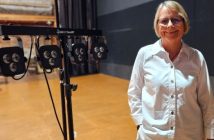Innovation and sustainability were the threads running through a Grow Waikato event focused on the dairy industry in September.
Gallagher deputy CEO Kahl Betham, one of five speakers at the forum held at Wintec’s Atrium, said the internet of things was having a huge impact on farming, with potential for improving animal health and productivity.
“The internet of things is the megatrend happening around the world,” he said.
That saw increasing numbers of sensors being deployed, offering enhanced information for farmers.
He said by keeping their research, development and manufacturing in Hamilton, Gallagher was well based to build sensors, communications networks and computer software that allows farmers to enhance their operations.
A key area for their sensors and software was the “really big problem” on farms of water management. It could take a farmer hours to locate the source of a water leak, leading to potential loss of productivity.
“We have developed a water flow meter, which was award winning at Fieldays, we’ve also partnered with an organisation to create technologies to get that data from the water flow meters, from sensors off farm, into the cloud, into apps, into farmers’ hands so they can make great decisions on a daily basis about how to manage their water and also to identify issues and resolve them quickly.”
Even more cutting edge is Gallagher’s move into tracking collars on cattle.
“This device has the ability to track an animal plus also to autonomously move the animal around without human intervention,” Betham said.
Inside the collar is a GPS unit and also a very small electric fence unit.
“What that allows the device to do is, you jump onto your computer, you draw a Google style map with a virtual fence on any part of your property that you wish and then when a cow starts moving towards that boundary they start to hear a sound. When they start to hear that sound they soon learn after a little while that if they keep going towards that virtual fence then they are going to get a shock. Trials that we have out there at the moment show they are 99 percent effective at keeping cattle inside that virtual fence.”
Not only that, the collar also has movement sensors that can detect whether the cow’s head is up or down, which means the farmer knows how well it’s feeding as an indication of animal health.
“We know where it’s been fed and in which paddocks, which is really great for farmers.”
The technology could also be used to keep animals out of waterways, and Betham could see potential uses around disease outbreaks and knowing which animals had been in contact with each other.
“We really do believe that the farming industry is ripe for this internet of things technology.”
Also presenting were Scottie Chapman, from Spring Sheep Milk Company, Fonterra’s Philippa Fourie, Waikato Innovation Park CEO Stuart Gordon and Hill Laboratories cofounder Roger Hill.
Fourie spoke about Fonterra’s environmental initiatives, and said sustainability presented opportunities.
She said they had a goal of net zero emissions by 2050 and zero waste to landfill by 2025. They have also been working on converting boilers to using biomass and tankers to biodiesel. “In terms of finished goods movement, we have targets around using rail more.”
Hill said soil testing, which in the past had been around maximising productivity, was likely to change as the focus goes on to environmental considerations. Water testing for farmers was likely to become a bigger part of the lab testing regime for the same reason.
He and his wife Ann founded Hill Laboratories 35 years ago. It is now based in the former Frankton NZ Post building where 350 people work, while it also has satellite labs around the country and a total workforce of 430.
“Generally we’re pretty heartened by the state of New Zealand agriculture and horticulture. Such a success story bodes well for the future for a testing organisation like ourselves,” he said.
Gordon spoke in his capacity as CEO of Food Waikato about the spray dryers at Innovation Park and the impact they had had, particularly on the goat and, latterly, the sheep milk industries.
He said more than $230 million of investment had been made in Greater Waikato as a result of having the first spray dryer, which was largely established by government money with a view to creating open access platforms for businesses to develop products.
A second dryer is being built at the site, and will be ready to go on April 7 next year.
“We see the real opportunity as the sheep milk industry.”
Those words were echoed by Scottie Chapman, CEO of Spring Sheep Milk Company.
“Spring Sheep has a very simple mission, it’s to become the world’s most valuable sheep milk brand and we’re going to be doing that right here out of Waikato,” he said.
He said since starting four years ago they spent – and continue to spend – a lot of time overseas researching, which led them to infant formula.
“The market has said there is demand for sheep milk because it’s very, very good nutritionally and it’s easier to digest than cows’ milk; and the consumer they want to use it for is the world’s most discerning consumer, the most precious consumer, it’s a baby.”
As a fifth generation sheep farmer from Otago, he said he would love to be setting up in Canterbury, Otago, and Southland.
“But you can’t. Waikato is the world’s home of nutrition. There’s more nutrition plants in Waikato for dairying than anywhere else on the planet; this is where it has to be. The infrastructure around here allows us to make it happen and create a new industry for New Zealand.
“What we have in Waikato is the ability to scale supply. So we can create something here on very very large scale.”
He said there were very low capital costs involved in converting older, smaller dairy farms that were getting near end of life.
“We’re creating models around taking the old infrastructure from Waikato, the smaller farms, and creating something that’s really valuable and adding high value product as opposed to a dairy farm that was running out of options. We’re really happy with what we’ve got here.”




